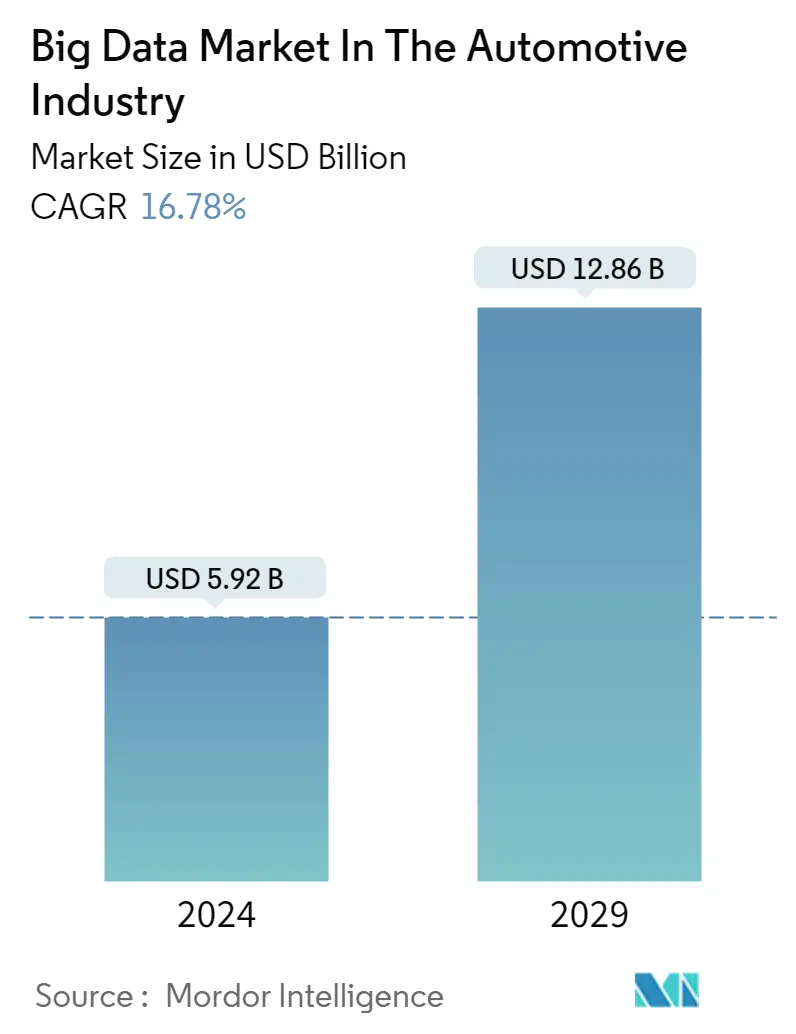Market Size of Big Data Industry In The Automotive Industry

| Study Period | 2019 - 2029 |
| Market Size (2024) | USD 5.92 Billion |
| Market Size (2029) | USD 12.86 Billion |
| CAGR (2024 - 2029) | 16.78 % |
| Fastest Growing Market | Asia-Pacific |
| Largest Market | Europe |
Major Players
*Disclaimer: Major Players sorted in no particular order |
Need a report that reflects how COVID-19 has impacted this market and its growth?
Big Data in Automotive Market Analysis
The Big Data Market In The Automotive Industry is expected to grow from USD 5.92 billion in 2024 to USD 12.86 billion by 2029, at a CAGR of 16.78% during the forecast period (2024-2029).
The automobile industry is being transformed by adopting technologies, applications, and services ranging from sensors to artificial intelligence to big data analysis; thus, the ecosystem is witnessing a steady influx of new players, resulting in the continuous evolution of the future car. Increasing efforts from various stakeholders in utilizing the vehicle-generated data coupled with a growing installed base of connected cars drive the market growth.
- Big data analytics allows the automobile manufacturing industry to collect data from ERP systems to combine information from multiple functional units of the business and the supply chain members. With the emergence of industry IoT, a networked system, and M2M communication, the automotive industry is positioning itself toward industry 4.0. Sensors, RFIDs, barcode readers, and robots are now standard on the industry's manufacturing floor. These devices have increased data generation points exponentially.
- The consumer electronics industry is highly dependent on the demand and supply factors. The use of big data analytics helped this industry segment drastically and allowed it to switch to a pull market strategy instead of the push market strategy. With big data analytics, the industry is now more aware of consumer behavior patterns and may plan production based on these. A similar potential has been exposed in the automotive sector, with IoT evolutions and electronics components becoming an integral part of automobiles.
- Furthermore, big data analytics helped automobile manufacturers boost their efficiency in terms of sales and marketing. It also improved its operations by aiding in the incorporation of utilities like predictive maintenance and service schedule. It also aided automotive vendors in streamlining the procurement process, making it more cost-efficient by analyzing the data for demand prediction.
- Data is increasingly becoming crucial for OEMs. Therefore, it is essential to ensure that they comply with the General Data Protection Regulation (GDPR) through a strong privacy strategy. An evident appreciation for data protection, and in particular the details of the GDPR, are required, as many in the industry are not yet familiar with existing regulations and internal policies. This may lead to miscommunication with the public. Therefore, data protection law is important in connected and autonomous mobility because the breadth of data captured automatically is tremendous.
- The recent outbreak of COVID-19 revealed the negative impacts of uncertainty on decision-making processes and markets. At the time point when market participants started to receive real-time information about the situation, the automotive markets began to ease. This is one scenario where big data can be used to amplify information to various stakeholders to prevent panic and to ensure market stability and security of supply.
